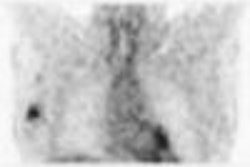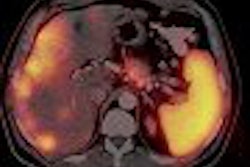Sometimes you just can't catch a break. PET and PET/CT proponents in the U.S. have fought long and hard to get their modalities included in the nonacademic diagnostic armamentarium. They have successfully battled the U.S. Centers for Medicare and Medicaid (CMS) reimbursement policies for their use in various neoplasms, received current procedure terminology (CPT) codes for billing a year ago, and last May were given the green light to inaugurate the National Oncologic PET Registry to ensure Medicare reimbursement for even more cancers.
But these victories, the result of years of passionate and dedicated effort by clinicians and scientists from a variety of interrelated disciplines, could be critically imperiled if reimbursement cuts mandated in the Deficit Reduction Act (DRA) of 2005 are implemented in less than three months, according to an article published in Molecular Imaging and Biology (September 2006, Vol. 8:5, pp. 254-261).
"There can be no doubt that the implementation of the DRA as written without a phase-in period will have a devastating impact on the U.S. healthcare system resulting in the forced closure of hundreds if not thousands of imaging centers and up to 50% of nonhospital PET/CT imaging providers," the authors wrote. "The dramatic role that PET/CT has played in reducing cancer deaths in the U.S. will be threatened, whereas surgical costs for Medicare beneficiaries will rise as a result of unnecessary surgeries that might have been eliminated by appropriate access to PET/CT services."
Early detection and better care have recently led to a decline in the number of U.S. cancer mortalities. A great part of this early detection has been the use of diagnostic imaging in discovering malignancies and, lately, of PET and PET/CT in the staging and localizing of neoplasms. According to the authors, in 2005 there were a little over 1.3 million PET or PET/CT scans performed in the U.S.
They cited American Cancer Society statistics for projected cancer indications in 2005 approved for CMS reimbursement at 727,000, and established a five-year survival rate overall for these patients. On this basis, the authors calculated that 3 million patients annually are eligible for PET or PET/CT scans, making the modality one of the most underutilized -- at less than 50% of approved indications -- in diagnostic imaging.
"This number is very conservative in that it does not take into account those patients that may actually need several PET/CT scans to monitor their ongoing chemotherapy or radiation therapy treatments," the authors noted. "It also does not take into account those patients who are fortunate enough to exceed the five-year survival rate and live well beyond that time. It is very conceivable that these patients would require a certain number of PET/CT scans into their sixth year of survival and beyond to properly assess and follow-up on their condition."
According to the authors, approximately 43% of the PET and PET/CT studies performed in the U.S. are conducted in a nonhospital imaging center. The DRA mandates that CMS reimbursement for the technical component of outpatient imaging procedures be the lesser amount of either the Hospital Outpatient Prospective Payment System (HOPPS) or the Medicare Part B Physician Fee Schedule (MPFS). Under this proviso, the technical component of PET/CT under the 2006 HOPPS rate is $1,250 per study with an additional $225 per dose of 18-FDG, resulting in a reimbursement of $1,475 per study.
The authors modeled a pro forma that found a nonhospital facility seeing an average of 3.3 PET/CT patients per day in a 260-day work year would see losses of approximately $102,000 by year end at the 2006 HOPPS reimbursement level. Adding in expenses such as legal and accounting consulting fees as well as radiation safety services, the authors maintain that the average PET/CT facility will be facing losses of more than $120,000 per center.
"Given the recent history of declines in this area, PET imaging centers will more likely be faced with additional cuts in the HOPPS rate, making the financial scenario for 2007 even worse," the authors noted bleakly.
Given that 63% of PET/CT utilization is by Medicare beneficiaries, private payor reimbursement will not be enough to make up the revenue shortfall for many imaging centers. The authors hold that many centers will close up shop, creating a ripple effect not only in the local economy but also in the larger molecular imaging market -- particularly among radiopharmaceutical suppliers and equipment manufacturers.
"Even if the market sees only a 25% reduction in new purchases, that will result in billions of (dollars in) lost sales and manufacturing to the economy between 2007 and 2010," they stated.
More onerous to the U.S. economy as a whole, the DRA cuts in PET and PET/CT reimbursement may actually serve to drive up overall healthcare costs. The use of the modalities in lung cancer patients, for example, has demonstrated a 13% decrease in overall costs to manage the disease. This has been achieved through the elimination of in-patient stays, surgeries, and unnecessary diagnostic tests, which accounts for a savings of approximately $1,500 per patient, according to the authors.
"It is interesting to note that although CMS imposes strict requirements on the utilization of PET, they impose no similar restrictions on other imaging services made unnecessary by the use of PET," they wrote. "By helping to ensure PET's widespread and appropriate use, CMS could truly recognize real savings rather than through arbitrary legislative reimbursement reductions that will actually increase the nation's overall healthcare spending."
The authors outlined three steps legislators can take before the DRA takes effect on January 1, 2007. First, they can call on Congress to enact legislation ensuring that any cuts to fees for imaging providers in both the hospital and nonhospital setting be phased in between 2007 and 2015, the period covered by the DRA. Second, they can request that PET and PET/CT's "New Technology" status be continued by CMS and that it be removed from the DRA's scope. Third, they urge a broader analysis of the impact that diagnostic imaging reimbursement cuts in the DRA will have on the U.S. economy and the healthcare of Medicare beneficiaries to assess the validity of its proposed savings versus economic and human harm.
By Jonathan S. Batchelor
AuntMinnie.com staff writer
October 13, 2006
Related Reading
DRA looming: Is your organization prepared? October 6, 2006
Study finds 87% of DRA reimbursement below procedure cost, September 19, 2006
Reassignment rule proposal offers mixed bag for imaging, August 18, 2006
DRA cuts affect more than imaging providers, August 2, 2006
DRA 2005 in practice: Where the rubber meets the road, April 27, 2006
Copyright © 2006 AuntMinnie.com




















